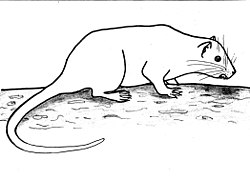
Capromyidae is a family of mammals in the order Rodentia and part of the Caviomorpha parvorder. Members of this family are called capromyids or hutias. They are found in the Caribbean on Cuba, Hispaniola, and nearby islands. They live primarily in forests, wetlands, and rocky areas, though some species can be found in shrublands, caves, and coastal areas. They range in size from the dwarf hutia, at 20 cm (8 in) plus a 17 cm (7 in) tail, to Desmarest's hutia, at 62 cm (24 in) plus a 31 cm (12 in) tail. Capromyids are omnivores and eat leaves, fruit, bark, and small animals. Most extant capromyids do not have population estimates, but two species—the Jamaican coney and eared hutia—are categorized as endangered species, and four—the Bahamian hutia, Cabrera's hutia, dwarf hutia, and San Felipe hutia—are categorized as critically endangered with adult populations of 100 or fewer. Eight species, including the subfamilies Hexolobodontinae and Isolobodontinae, were driven extinct after 1500 due to the European colonization of the Americas and introduction of non-native rats, with some species surviving until the 1900s. [1] [2]
Contents
- Conventions
- Classification
- Capromyids
- Subfamily Capromyinae
- Subfamily Hexolobodontinae
- Subfamily Isolobodontinae
- Subfamily Plagiodontinae
- References
- Sources
The ten extant species of Capromyidae are divided into two subfamilies: Capromyinae, containing nine species in four genera; and Plagiodontinae, with a single species. In addition to the two extinct subfamilies, Capromyinae contains two species and Plagiodontinae three species made extinct since 1500. Capromyidae has been proposed to be merged into the family Echimyidae as the subfamily Capromyinae, with its subfamilies converted to lesser clades, but the proposal is not yet universally accepted. [3] A few extinct prehistoric capromyid species have been discovered, though due to ongoing research and discoveries, the exact number and categorization is not fixed. [4]











